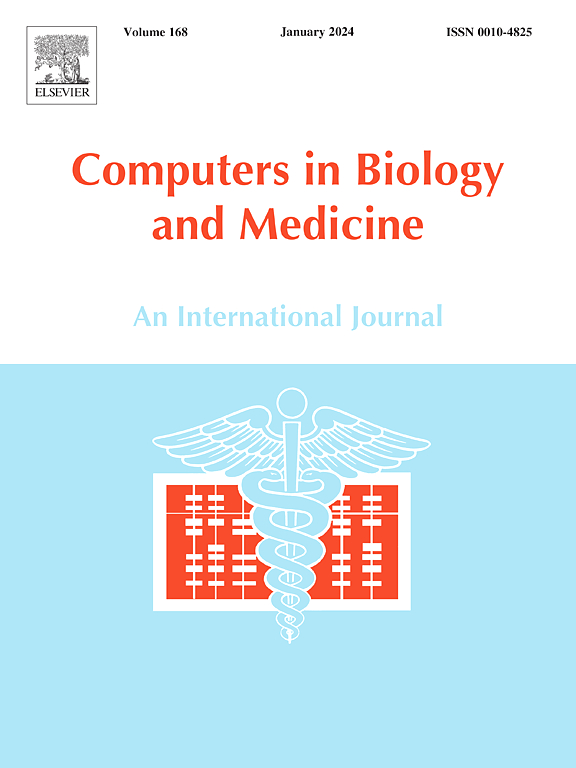通过下巴肌电图自动筛选中枢性呼吸暂停和呼吸不足的超低功耗芯片系统
IF 7
2区 医学
Q1 BIOLOGY
引用次数: 0
摘要
中枢性呼吸暂停(CA)和中枢性低通气(CH)是由于大脑无法向呼吸肌发出信号而引起的睡眠障碍,可能导致严重的并发症,如心力衰竭。本研究提出了一种新的系统,用于自动检测睡眠呼吸暂停患者的CA和CH事件,该系统将前馈神经网络(FdNN)架构集成到具有下巴肌电(EMG)信号的超低功耗片上系统(SoC)中。该SoC通过精心优化FdNN架构、硬件设计和电路级考虑,实现了低于1mw的功耗,确保了高精度事件检测的高效运行。使用ISRUC数据库进行训练和测试,优化后的FdNN模型证明了表面肌电信号(sEMG)特征在识别CA和CH事件方面的有效性,测试准确率达到85.7%。提出的支持向量机(SVM)核近似模型表现出优异的性能,同时对FdNN架构进行了优化,增强了其硬件兼容性。该SoC采用GlobalFoundries 22 nm full贫化绝缘体上硅(GF 22 nm FDSOI)技术,内核面积为0.0170 mm2,工作频率为100 MHz, 0.72 V时功耗为602 μW,漏功率为0.263 μW。此外,斜率符号变化(SSC)被提议作为一种数字生物标志物,强调需要通过统计分析来区分CA和阻塞性呼吸暂停,以及CH和阻塞性呼吸不足。综上所述,该SoC提供了高效且复杂的自动CA和CH事件筛查,以帮助临床医生诊断和治疗睡眠障碍,为传统的多导睡眠图(PSG)方法提供了一种替代方案。本文章由计算机程序翻译,如有差异,请以英文原文为准。
Ultra-low-power System-on-Chip for automated screening of central apnea and hypopnea via chin electromyography
Central Apnea (CA) and Central Hypopnea (CH) are sleep disorders arising from the brain’s inability to signal respiratory muscles, potentially leading to severe complications such as heart failure. This study presents a novel system for automating CA and CH event detection in sleep apnea patients using a feedforward neural network (FdNN) architecture integrated into an ultra-low-power System-on-Chip (SoC) with chin electromyography (EMG) signals. The SoC achieves sub-1-mW power consumption through careful co-optimization of the FdNN architecture, hardware design, and circuit-level considerations, ensuring efficient operation with high-accuracy event detection. Using the ISRUC database for training and testing, the optimized FdNN model demonstrates the effectiveness of surface EMG (sEMG) features in identifying CA and CH events, achieving a notable testing accuracy of 85.7%. While the proposed support vector machine (SVM) kernel approximation model shows superior performance, optimizations to the FdNN architecture enhance its hardware compatibility. Implemented on GlobalFoundries 22 nm Fully Depleted Silicon-On-Insulator (GF 22 nm FDSOI) technology, the SoC achieves a core area of 0.0170 mm, running at 100 MHz, and consumes 602 W at 0.72 V with a leakage power of 0.263 W. Additionally, slope sign change (SSC) is proposed as a digital biomarker, emphasizing the need to distinguish between CA and obstructive apnea, as well as CH and obstructive hypopnea, through statistical analysis. In conclusion, the proposed SoC provides power-efficient and sophisticated automated CA and CH event screening to help clinicians diagnose and treat sleep disorders, offering an alternative to traditional polysomnography (PSG) methods.
求助全文
通过发布文献求助,成功后即可免费获取论文全文。
去求助
来源期刊

Computers in biology and medicine
工程技术-工程:生物医学
CiteScore
11.70
自引率
10.40%
发文量
1086
审稿时长
74 days
期刊介绍:
Computers in Biology and Medicine is an international forum for sharing groundbreaking advancements in the use of computers in bioscience and medicine. This journal serves as a medium for communicating essential research, instruction, ideas, and information regarding the rapidly evolving field of computer applications in these domains. By encouraging the exchange of knowledge, we aim to facilitate progress and innovation in the utilization of computers in biology and medicine.
 求助内容:
求助内容: 应助结果提醒方式:
应助结果提醒方式:


